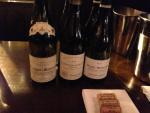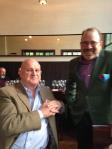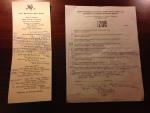
The dinner program reads: “Becky Wasserman Selection, Esquin Wine & Spirits, Restaurant Zoe & Cordon Selections Present: An Evening of Burgundy with Peter Wasserman, September 30, 2013.”
Be still my Burgundy-beating heart. A wine dinner here in Seattle – with Peter Wasserman. Peter Wasserman of Burgundy’s legendary Becky Wasserman Selections. Becky Wasserman, guest instructor for French Wine Society’s Bourgogne Master-Level Immersion Program. The Bourgogne Master-Level Immesion Program I’m attending in two weeks, studying Burgundian wines. Burgundian wines like those poured at dinner with Peter Wasserman.
It’s important to note here that there’s no such thing as a free lunch, or in this case, a free wine dinner. Attendance to this event is dear – about a cost of a bottle of Burgundy Grand Cru per person. Not exactly a bargain, but a great way to taste through a region with an expert guide. One price, 10 wines, 7 courses. Three hours pass quickly.
Peter Wasserman exudes effortless charm; his personal anecdotes play well to an enthusiastic gathering of Bourgogne-lovers, collectors, and this geek. As Restaurant Zoe plies us with thoughtfully-prepared artisinal fare, Peter navigates us gracefully through the maze that is Burgundy.
Peter speaks first to that most Burgundian of terms, terroir: ”Terroir encompasses not only the geology, but drainage (how the soil retains and releases water), exposition (west, east, south, north and all attending variations, which informs differences in temperature), height on the slope (mid-slope is best because the sun stas there longest throughout the day), and the hand of man – something many people leave out when talking about terroir.”
‘The hand of man’? Zut alors! Forget Adam Smith’s ‘invisible hand’ and all you learned in Econ 101. Peter defines the ’the hand of man’ as ”modifying land” through such devices as retaining walls to prevent erosion – thereby creating a layer of slope wash around it – or the reclamation of quarries, or incorporation of plant material.
But this is Burgundy. Where the ‘who’ of wine makers and négotiants inform the final product as much as the ‘where’ of terroir.
Négotiants and wine makers oversee a wine’s élevage, or upbringing. Each vary in style and approach, from old school Jean- Noel Gagnard to cutting edge Bejamin Leroux covered in the Tasting Notes below.*
In addition to discussions of terroir and production, Peter also mentions a big about tasting – specifically, the three (3) stages of tasting Burgundian wine:
1. Primary: This phase unlocks the fresh fruit aromas.
2. Secondary: This phase reveals the wine’s structure.
3. Tertiary: The final phase leaves the fresh fruit aromas behind and marries structure with maturity in developed noses often containing hints of mushrooms, earth, forest floor. Too much maturity may exude too much sweetness or ‘pluminess.’
Much to learn. Much to taste. Much to enjoy.

Burgundy wine expert Peter Wasserman, son of wine vigneron Becky Wasserman.
" data-orig-size="2448,3264" data-image-title="Burgundy Wine Vigneron Peter Wasserman" data-orig-file="http://binnotes.files.wordpress.com/2013/10/img_5411.jpg" data-liked="0" height="150" data-reblogged="0" width="112" data-medium-file="http://binnotes.files.wordpress.com/2013/10/img_5411.jpg?w=225" aperture="aperture" />Tasting Notes* and Menu**:
Hors d’oeuvre: Steak Tartare on Crostini
2008 Jean Noel Gagnard Cremant de Bourgogne
(NOTES: Blanc de Noir, 3 yrs old. sourced from St. Aubin, Côte de Beaune – high acid. Dry, floral, discrete finish.** Nice.)
Amuse Bouche: Oyster with Citrus Caviar
Beet Salad with Baby Greens & Ricotta Gnudi wih Mushroom Bouillon
2010 Jean Noel Gagnard Chassagne-Montrachet 1er cru Caillerets
(NOTES: Some consider Caillerets the best of Chassagne-Montrachet 1er cru; the name means ‘small rocks’, the soils contain iron deposits, which give the wine a piquance and heft. Jean Noel Gagnard espouses traditional production, minimal (1x) batonage (stirring of lees). THIS WINE SUPRISES AS IT OPENS UP. Peter asked us to revisit the wine ~30 minutes after pouring; light elegance replaced weighty unctiousness, shifting this wine near the top of my fave list. **Nice.)
2010 Maison Camile Giroud Corton Charlemagne Grand Cru
(NOTES: Corton-Charlemagne – hello! Here’s an anecdote: Once the vineyards of Emperor Charlemagne, who liked his wine – and his Queen, who didn’t like his red-wine stained beard – ’requesting’ he plant white grapes instead, or so the legend goes…Maison Camile Giroud practices minimal manipulation.)
2011 Benjamin Leroux Puligny-Monrachet 1er cru Champs Gains
(NOTES: Benjamin Leroux prefers modern production methods, including no batonage. Champ Gains contains less iron and clay, upslope, SW exposure, cooler in the evening; the wine possesses more tone and minerality. ***binNotes’ personal fave of this flight.)
Black Cod with Roasted Cauliflower
2011 Benjamin Leroux Savigny-les-Beaune
(NOTES: Located at the mouth of a canyon, the soil is alluvial.)
2011 Domaine Simon Bize Savigny-les-Beaune 1er cru Talmettes
(NOTES: Talmettes comprises part of renown 1er cru Les Vergelles. D. Simon Bize used whole cluster fermentation. Lots of honey, clover, high acid.)
Duck Leg Confit with Lentils and Baby Turnips
2010 Camile Giroud Charmes Chambertin Grand Cru
(NOTES: Some ‘experts’ may consider Charmes Chambertin a ’2nd Tier cru. This wine was no 2nd Tier cru. Maison Camile Giroud employs cold soak, pigeage (punch down), 100% destemming, and minimal extraction, resulting in a pungent, dulcet-toned wine.**Nice.)
2010 Lignier Michelot Charmes Chambertin Grand Cru
(NOTES: Lignier Michelot is ‘new school’, practicing 3 levels of triage to ensure pristine fruit, and use100% whole cluster fermentation. Even saucier than the Camille Giroud. ***binNotes personal fave for this flight,)
Cheese course
1976 Camile Giroud Nuits-St-Georges 1er cru Vaucrains
(NOTES: 1976 was one of the hottest vintages on record in Burgundy, resulting in grapes with thicker skins and higher tannins, therefore slower maturation; best enjoyed after 2003. This wine, from Middle Nuit, is rich, strong, sturdy, highly structured.)
1976 Camile Giroud Vosne Romanee 1er cru Suchot
(NOTES: A highly rated 1er cru, this wine exhibits a seasoned, silky texture.)
Chocolate by Dolceta Artisan
**(NOTE: Vegan substitutes graciously provided by Restaurant Zoe for the author not included – thanks, Derek!)

The evening ends with a sweet little vignette Peter shares while unleashing the pair of 1976 Côte de Nuit Premier Crus:
“I was twelve at the time,” he begins. “It was a very dry year – a heat wave. So dry my brother and I could fit our arms in the cracks in the ground. ” Peter remarks how “well” the 1976 wines are pouring “now” – ‘now’ the relative term here. In Burgundy, wines sometimes take two generations or more to reveal their secrets.
As my Burgundy wine dinner with Peter Wasserman underscores, understanding Burgundy and Burgundian wines requires great patience. No easy task in this haste-driven world. But make no mistake – the reward is worth the wait. These wines prove it.
Santé!
Note: To learn more about the wine makers and négotiants discussed in this post, please go to LesSerbet.com.
Copyrighted 2013. All Rights Reserved.
Filed under: Wine Tasting Tagged: Becky Wasserman, Becky Wasserman Selections, Burgundy, Burgundy Grand Cru, Burgundy wine, Cordon Selections, elevage, Esquin Wine & Spirits, food, French Wine Society, negotiant, peter wasserman, pigeage, premier cru, Restaurant Zoe, terroir, wine, wine maker, Wine writer

